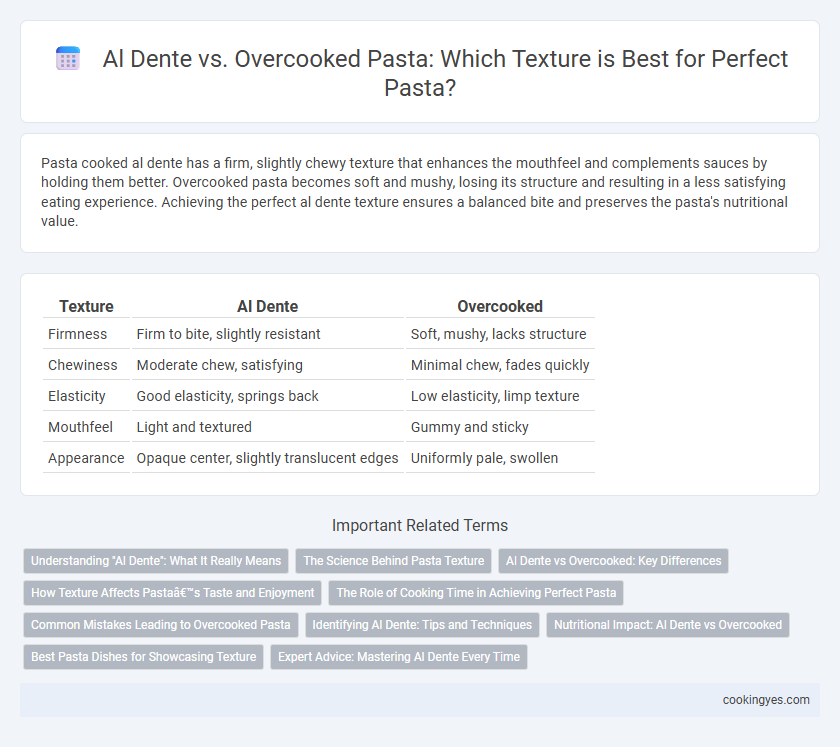Pasta cooked al dente has a firm, slightly chewy texture that enhances the mouthfeel and complements sauces by holding them better. Overcooked pasta becomes soft and mushy, losing its structure and resulting in a less satisfying eating experience. Achieving the perfect al dente texture ensures a balanced bite and preserves the pasta's nutritional value.
Table of Comparison
| Texture | Al Dente | Overcooked |
|---|---|---|
| Firmness | Firm to bite, slightly resistant | Soft, mushy, lacks structure |
| Chewiness | Moderate chew, satisfying | Minimal chew, fades quickly |
| Elasticity | Good elasticity, springs back | Low elasticity, limp texture |
| Mouthfeel | Light and textured | Gummy and sticky |
| Appearance | Opaque center, slightly translucent edges | Uniformly pale, swollen |
Understanding "Al Dente": What It Really Means
Al dente pasta is cooked to be firm to the bite, preserving a slightly chewy texture that enhances the eating experience and retains nutrients. Overcooked pasta becomes soft and mushy, losing its structural integrity and diluting the flavor in sauces. Achieving al dente requires precise timing based on pasta type and thickness, which ensures optimal texture and taste balance.
The Science Behind Pasta Texture
The science behind pasta texture revolves around starch gelatinization and protein coagulation, which dictate the firmness and chewiness of cooked pasta. Al dente pasta maintains a firm center due to incomplete starch gelatinization and a stronger gluten protein matrix, while overcooked pasta becomes mushy as gelatinized starch swells excessively and protein structures break down. Understanding water absorption rates and cooking temperatures is essential for achieving the ideal al dente texture that balances softness with resilience.
Al Dente vs Overcooked: Key Differences
Al dente pasta boasts a firm texture with a slight chew, enhancing flavor absorption and providing a satisfying bite, whereas overcooked pasta becomes overly soft and mushy, losing its structural integrity. Al dente cooking preserves the pasta's starch granules, preventing excessive stickiness and ensuring a balanced mouthfeel. Overcooked pasta releases more starch, resulting in clumping and a less desirable, limp texture that diminishes the overall dining experience.
How Texture Affects Pasta’s Taste and Enjoyment
Al dente pasta offers a firm texture that enhances the natural flavor and allows sauces to cling effectively, creating a balanced mouthfeel and satisfying bite. Overcooked pasta becomes mushy, diluting the taste and reducing the contrast between the pasta and sauce, which can lead to a bland and less enjoyable eating experience. Texture plays a crucial role in pasta enjoyment, impacting flavor perception and overall satisfaction.
The Role of Cooking Time in Achieving Perfect Pasta
Cooking time critically influences pasta texture, with al dente achieved by firm, slightly resistant noodles that retain shape and bite. Overcooked pasta becomes soft, mushy, and loses structural integrity, diminishing the dining experience. Precise timing, typically followed by immediate draining, ensures optimal starch gelatinization and ideal mouthfeel.
Common Mistakes Leading to Overcooked Pasta
Overcooked pasta often results from boiling it too long or using excessive water, causing the noodles to become mushy and lose their firm, al dente texture. Common mistakes include not monitoring cooking time carefully and neglecting to taste the pasta periodically during boiling. Proper timing and frequent checking are essential to achieving perfect al dente pasta with the ideal balance of firmness and tenderness.
Identifying Al Dente: Tips and Techniques
Identifying al dente pasta involves checking for a firm texture with a slight resistance in the center, achieved by cooking the pasta just until it retains a bit of chewiness. To test, bite into a piece or cut it with a fork to observe a thin white core, signaling it is perfectly cooked. Using timing guidelines from the pasta packaging and tasting frequently during the last few minutes helps prevent overcooking and ensures ideal texture for sauces to cling effectively.
Nutritional Impact: Al Dente vs Overcooked
Cooking pasta al dente preserves more of its resistant starch, which supports better blood sugar control and digestive health compared to overcooked pasta, where the starch becomes highly gelatinized and easier to digest, leading to quicker glucose absorption. Al dente pasta also retains a firmer texture and higher nutrient density, including B vitamins and minerals, which can be diminished by prolonged cooking times. Overcooked pasta tends to have a softer, mushier texture and a higher glycemic index, potentially impacting energy levels and satiety negatively.
Best Pasta Dishes for Showcasing Texture
Al dente pasta offers a firm, slightly chewy texture that enhances dishes like spaghetti aglio e olio and penne arrabbiata, providing a satisfying bite that holds up well to robust sauces. Overcooked pasta becomes soft and mushy, which can detract from dishes such as fettuccine Alfredo or lasagna where the contrast between pasta and sauce textures is crucial. Mastering the perfect al dente texture is essential for showcasing the nuanced interplay of pasta and sauce in classic Italian recipes.
Expert Advice: Mastering Al Dente Every Time
Expert chefs emphasize the importance of cooking pasta al dente to preserve its firm texture and enhance flavor absorption. Overcooked pasta becomes mushy and loses nutritional value, diminishing the overall dish quality. Mastering precise cooking times and frequently tasting pasta ensures the perfect al dente texture consistently.
Al dente vs Overcooked for texture Infographic

 cookingyes.com
cookingyes.com